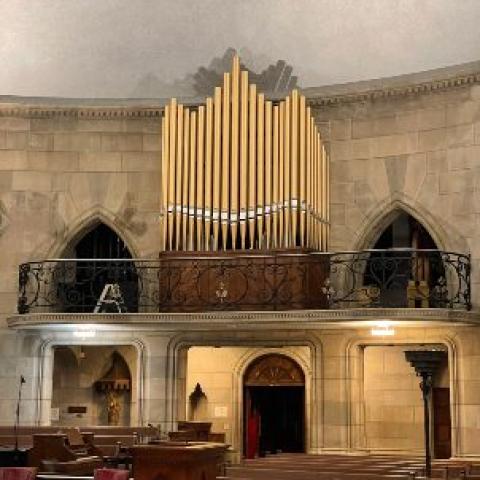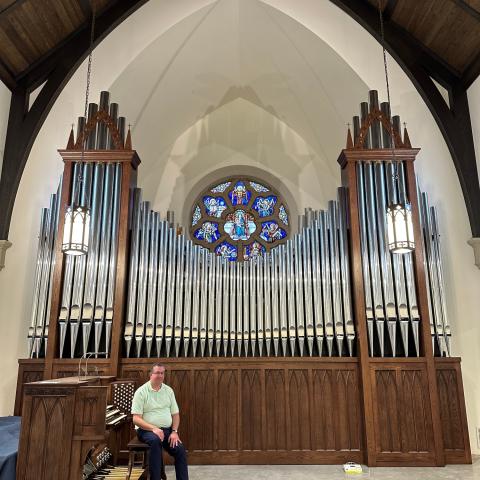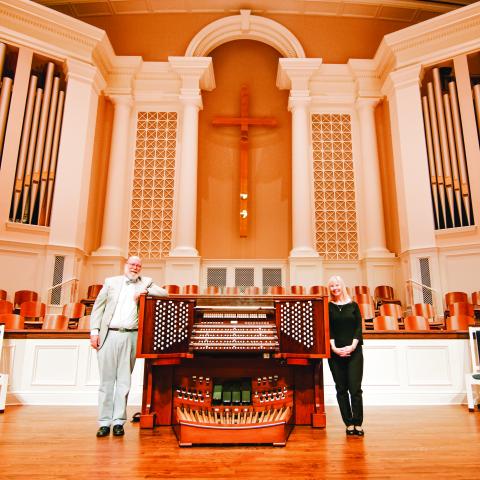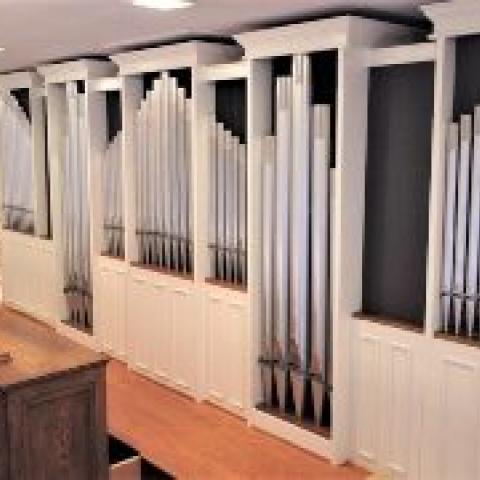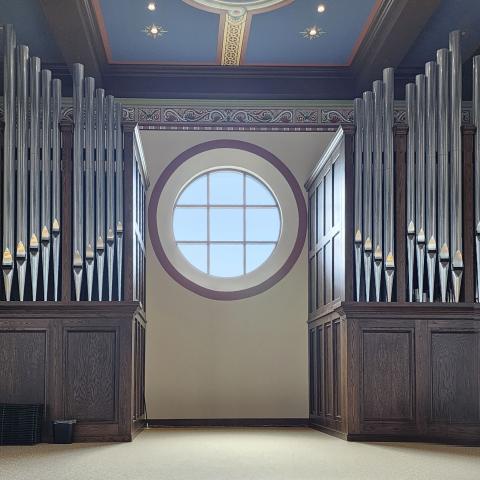Kegg Pipe Organ Builders, Hartville, Ohio; Main Street United Methodist Church, Abbeville, South Carolina
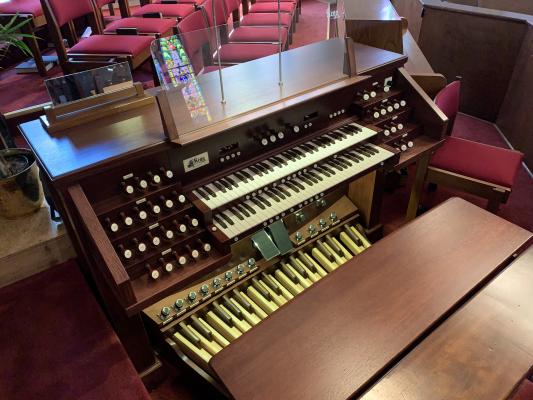
Working in the South has its advantages. The climate can be most pleasant, but the main attraction is its people. Southern hospitality is real, and the folks at Main Street United Methodist Church certainly showed this to us in great measure.
When we first visited we found a handsome 19th-century Felgemaker case with highly decorated pipes. Behind it was an ailing Möller instrument built during the soft zinc era. Pipes were of thin metal, and the zinc basses were sagging. While we are always happy to retain worthy pipes and chests from existing instruments, the only parts of the previous organ we thought worthy were the chime tubes and the fine Felgemaker case. This case has speaking pipes, but sadly, all had been mute for decades.
The new instrument we have built consists of ten ranks of pipes, shared over two manuals and pedal. The stoplist is similar to others we have built of this size, with some special considerations. The 300-seat worship space of Main Street United Methodist Church would be familiar to many. It is a handsome room with vaulted plaster ceilings held up by ornate wood trusses. It is almost square with a raked floor and no balcony. Fully carpeted, it is an intimate room requiring a warm, rich, and powerful organ sound with a wide dynamic range. Such a space requires special voicing attention since any imperfections will be obvious. The Kegg company was chosen after a visit to Winnsboro, South Carolina, where the organs of Sion Presbyterian Church and First United Methodist Church were heard.
This instrument is a unit organ with careful attention to design and execution for which we have become known. In order to be successful, such organs must have special pipe scaling along with the dynamic balance of each rank of pipes that is different from such stops when in a straight design. Another key to successful unit design is restraint. One must resist the urge to violate this rule. Stops are designed with borrows for variety, but with discipline and a solid chorus in mind. The most important rule is an 8′ Principal with a 4′ Octave as two proper and independent stops. Couplers are provided with care and purpose. This is to help avoid double coupling of unit stops, which could destroy the thoughtful design. Unison couplers are not a concern, but octave couplers must have a specific use and not be able to do harm. For example, octave couplers are provided on the Swell to provide special effects such as massed strings, but there are no octave couplers to the Great.
The organ contains one stop that we have never before included on an instrument of this size, which is the Flute Celeste to join the Spitzflute. A Flute Celeste should be mysterious in the E. M. Skinner tradition, providing a soft blanket of sound. Our Spitzflutes as built in this style of instrument have a milky sound in the lower and mid ranges that appear to be quiet, especially with the shades closed. Here the Flute Celeste works beautifully. Because the Spitzflute ascends in volume to make a successful 2′, the upper range becomes louder. The Celeste is kept at the softer volume. Since the treble of the Spitzflute is louder, we purposely provide no way to couple the Flute Celeste at 4′ pitch, which would ruin the heavenly effect.
Because the Flute Celeste provides a lovely soft sound, the Viola and Celeste could be made somewhat more aggressive than they might have otherwise been. On the keen side, these provide another dynamic level as well as a character stop that blends well and adds texture to other stops.
The Mixture on this organ is derived from the Octave and the Quinte. Rooms such as this really require only a suggestion of a Mixture to make a pleasant chorus sound, and our “pretend” Mixture does this well. Larger rooms might require a genuine Mixture, but given the space limitations, we think the extra color of the second reed and second celeste is more useful for this client.
The reeds are what you might expect from a Kegg organ. The Trumpet is dark and commanding in the bass, which provides a solid footing. The stop morphs into a bright sound in the treble, making the unit Clarion successful for added fire. The capped Oboe is patterned after a Skinner Flügelhorn, making a fine solo stop or minor chorus reed.
The only unenclosed stop in the organ is the 8′ Principal on the Great. This stop also plays in the Pedal at 8′ and 4′. For its bass, we restored the fine Felgemaker façade, using the center 17 pipes. These pipes were cleaned and restored with advice from historian Marylou Davis. The scroll tuners were in poor shape and were replaced with inside slide tuners. Inside slide tuners are easy to tune and cause no wear on the pipe. I have had experience with pipes like these and knew they would work well with our voicing style. They required very little voicing to blend seamlessly with our new work and have a remarkably contemporary sound. The other case pipes include wood pipes, also with painted decorations.
The overall effect of this instrument is one that belies its size. It seems larger than it is. The derived Mixture is compelling, and the tutti satisfying. With the unusual dynamic range and the amount of color and variety available, one might think this organ is perhaps twice its rank count.
We would like to thank organist Dennis Kollmann, Pastor Brian Arant, and the congregation of Main Street United Methodist Church for their enthusiastic support throughout this project. We look forward to many years of continued friendship.
Kegg Pipe Organ Builders: Philip Brown, Mike Carden, Cameron Couch, Joyce Harper, Philip Laakso, Bruce Schutrum
GREAT
8′ Diapason (17 existing pipes, 44 new pipes)* 1
8′ Viola (from #5)
8′ Spitzflute (from #4 & #7)
8′ Flute Celeste (TC, 49 pipes) 2
4′ Octave (73 pipes) 3
4′ Rohrflute (from #4)
2′ Piccolo (from #7)
III Mixture (from #3 & #8)
8′ Trumpet (from #9)
8′ Oboe (from #10)
Chimes (existing bells, new action)
Swell to Great 8
* Unenclosed
SWELL
8′ Rohrflute (73 pipes) 4
8′ Viola (61 pipes) 5
8′ Viola Celeste (TC, 49 pipes) 6
4′ Principal 4’ (from #3)
4′ Spitzflute (73 pipes) 7
2-2⁄3′ Nazard (TC, from #8)
2′ Octave (from #3)
1-1⁄3′ Quinte (49 pipes) 8
16′ Bassoon (TC, from #10)
8′ Trumpet (73 pipes) 9
8′ Oboe (61 pipes) 10
4′ Clarion (from #9)
Tremulant
Swell to Swell 16
Swell Unison Off
Swell to Swell 4
PEDAL
16′ Bourdon (12 pipes & from #4)
8′ Diapason (from #1)
8′ Flute (from #4)
8′ Viola (from #5)
4′ Octave (from #1)
16′ Trumpet (12 pipes & from #9)
8′ Trumpet (from #9)
4′ Oboe (from #10)
Great to Pedal 8
Swell to Pedal 8
Swell to Pedal 4
ADJUSTABLE COMBINATIONS
150 memories
Great 1 2 3 4 5 Thumb
Swell 1 2 3 4 5 Thumb
Pedal 1 2 3 Toe
General 1 2 3 4 5 6 7 8 Thumb & Toe
General Cancel Thumb
Set Thumb
Undo Thumb
Clear Thumb
Range Thumb
Next Thumb and Toe
REVERSIBLES
Great to Pedal Thumb & Toe
Full Organ Thumb & Toe
ACCESSORIES
Expression Pedal
Concave and radiating pedal clavier
Adjustable bench
Full Organ indicator light
Crescendo Pedal with numeric indicator
Transposer
Integral performance record/playback
Pencil drawer
Cup holder
TONAL RESOURCES
10 ranks
646 pipes
Builder’s website: www.keggorgan.com.
Church website: www.mainstreetumcabbeville.org

